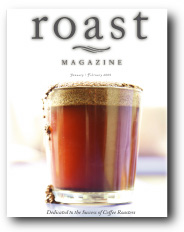Timing acidity Strategies for espresso roasters by Willem boot
.
Defining acidity
In coffee, acidity and the perception of acidity are not the same. Let's investigate the large family of chemical compounds that make up acidity in coffee.
An arverage cup of arabica coffee contains up to 200 milligrams of chlorogenic acid. In a pure form, these acids have a distinctbitter taste, and the reasting process - even at lighter roast levels-helps to reducetheir content. From a chemicla point of view, chlorogenic acid are esters formed between trans-cinnamic acid and quinic acid. Chlorogenic acid contain very strong antioxidants that have proven health benefits. Recent studies have shown the positive health effectof the intake of chlorogenic acids through the consumption of coffee. The polyphenols in these acids help to prevent cancer and other degenerative diseasers.
An important group of acid in coffee aer the organic acid, consisting mainly of malic, tartaric, phosphoric, acetic, quinic and the ctric acid. Let's review some essential taste characteristics of these acids. Citric acids can cause the unpleasant sourness of under-ripe fruit or the appealing, pleasant notes of lemons, limes, oranges or kiwis. In this case, the threshold of quality is determined by the level or ripening in the coffee cherry, leading to a higher sugar content of the fruit, which obviously affects the sweetness perception of the acid. Acetic acids are generally perceived as bad; they cause the distinct unpleasant flavor of defective, verfermented coffee. Some natural processed sundried coffees contain miniscule levels of acetic acids, causing a pleasant winey flavor in the cup. Malic acids produce tart flovors in coffee, which resemble the taste of green apples. How about phosphoric acid. they also contribute to the perceived sweetness in the cup. An interesting study in the '90s revealed the valuable properties of phosphoric acid, which can be found specifically in East African coffees from Ethiopia and Kenya. The study showed that a record-prize-winning Kenyan coffee from the region of Kagumo contained a significantle higher level of phsphoric acid than average Kenyan coffees. In this context, I strongly recommend participainting in a Q gradinf and cupping training, which is organized by the Coffee Quality Institute (CQI). One of the trainingsesseins consists of a sensory test is, indeed, a positive impact on cup quality. The perceived quality and sweetness increases dramatically after adding only a manimal amount of phosphoric acids to the coffee.
From a chemistry point of view, the common expression for acidity is pH, a scale that measures the intensity of acidity betwwen the nimbers 0 and 14. The scale is investered; a higher nimber reflects a lower acidity intensity level and each point increase or decrease reflects a ten-fold difference. For example, lemon juice, which is very acidic, has an average pH-level of 2.0 while fresh water is netural at a pH level of 7.0. A cup of gravity-drip-brew specialty coffee will show an average pH of 4.5 to 5.0. While conducting a taste test, I discovered that my threshold between medium and low acidity lies around a pH of 5.0. Although I am no recommending that you should start measuring the pH of your espresso drinks on an ongoing basis, I would absolutely advise performing taste tests to identify your own preferred threshold for acidity.
So, can we rely on numbers alone when studying the perception of the acidity in coffee? Of course not. Coffee chemistry is too complex for such a simplistic solution. The composition of acids and thier intensity may vary widely as a result of variety, soil, processing style, and roasting and preparation techniques. As a result we must reconize that all these factors will have a significant impact on the final brew. In this context, I believe that that roasters mostly struggle with excess ctric acid in their espresso drinks rather than any of the other acid that we discussed. Just recently, I prepared a Kenya Karaniwith a very pleasant sweet, lingering acidity. Instead of the feared sour notes in my espresso drink, I encountered a delicious complexity with sweet layers of refreshing fruit and a slightly dry sensation (like in fully ripe black mission figs). In this case, I suspect that the phosphoric acids of this Kenya contributeed to the pleasant balance Between sweetness and acidity.
이 글은 커피에 산미를 부여하는 화합물들에 대해 조사한 것이다. 아라비카 커피 한잔에는 평균 chlorogenic산을 200밀리그램까지 포함하고 있다. 화학적으로 보자면 chlorogenic산은 trans-cinnamic acid와 quinic acid에 의해 형성된 커피에 산미를 부여하는 중요한 것들 중 하나는 바로 유기산으로 말릭산, 주석산, 인산, 초산, 퀴닉산, 구연산등이 바로 이것이다. 이러한 산 중 필수적인 맛과 특징을 검토해보기로 하자. 구연산은 덜익은 과일에서는 불쾌한 신맛을 유발하는 성분으로 초산은 일반석으로 좋지않은 맛으로 인식된다. 사과산은 커피에 톡 쏘는 산미를 부여하는데 청사과의 맛과 흡사하다. 인산은 어떠할까. 이것은 또한 커피를 마실때 단맛을 인지하는데 공헌한다. 이런 맥락을 통해 나는 CQI에 의해 체계화 된 Q그레이딩 및 커핑훈련을 추천하고 싶다.
숫자가 높을수록 산도는 낮고 숫자간 산도는 10배의 차이가 난다. 담수의 경우 중성으로 pH7.0이며 강한 산성을 나타내는 레몬쥬스의 경우 평균 pH2.0을 나타낸다. 핸드드립으로 추출된 커피의 경우 보통 pH5.0~4.0이다. While conducting a taste test, I discovered that my threshold between medium and low acidity lies around a pH of 5.0. 비록 난 당신 에스프레소의 pH측정을 지속적으로 권하는 것은 아니지만 고객의 선호도 예측을 위한 에스프레소의 산도 측정은 필요하다고 생각한다. 그런데, 우리가 커피의 산미를 이해하려고 할 때, 이 수치를 (:pH) 얼마나 믿어도 될까. 당연하게도 단순화 시키기엔 커피와 관련한 변수가 너무나 많다. 산미와 관련한 다양한 성분들과 그 정도를 변화시킬 수 있는 토양이나 경작방법, 가공방법, 로스팅등등으로 인해 언제든 변할 수 있는 것이다. 이러한 많은 요소들은 영향력이 크기 때문에 결국 결과적으로 인식해야 하는 것이다. 이러한 맥락에서 대부분의 로스터들이 특히 에스프레소의 신맛에 대해 고민하고 있다고 생각한다. 최근에 나는 아주 달콤하면서도 비교적 온화한 산미의 케냐 Karani를 준비했다. 신맛에 대한 두려움을 뒤로 하고 내 에스프레소에는 상쾌하면서도 달콤한 과일의 느낌, 약간 마른듯한(잘 익은 무화과와 같은)과일 같은 풍부한 맛이 살아났다. 케냐 커피가 산미와 달콤함 사이의 밸런스를 아주 균형있게 잡아준것이다.
|
